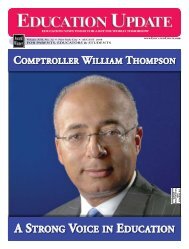Create successful ePaper yourself
Turn your PDF publications into a flip-book with our unique Google optimized e-Paper software.
June 2008 ■ EDUCATION UPDATE ■ spotlight on schools7PRESIDENT LOGAN, CSA SPEAKSLet’s Clear the RecordBy Ernest LoganWhen I took office more than a year ago, Iwas determined to gain for my members, schoolsupervisors and administrators, the respect theydeserve for the magnificent job they do as wellas the resources they need to pursue excellencein our schools.I reached out to colleagues in the labor movement,state and city lawmakers, public advocacyorganizations, businessmen and women who supportour schools and our own supervisors withinthe Department of <strong>Education</strong>. I believe I havebeen successful in making large strides towardsthat goal: Many school supervisors are finallyreceiving the recognition they deserve for theircontribution towards making this city a betterplace to live, a better place to work and a betterplace in which to raise children.CSA members—NYC’s public school leaders—havebecome the go-to people. When difficultquestions arise about schools and education,we’re known for providing in-depth answers inboth our private and public conversations. Wedon’t provide the easy answers, or answers ourquestioners may want to hear, but our expertise isvalued and so is our integrity.That integrity, however, is sometimes calledinto question without justification. Increasingly,CSA members are distracted by unwarranted,unjustified and, sometimes, absurd allegations.Sometimes these allegations are anonymousand sometimes they seem to be made in directresponse to criticism or an unsatisfactory rating.These retaliatory tactics are time-consumingand costly; by law, investigators mustbecome involved, and then lawyers must dukeit out. Worse, a supervisor must waste timedefending his good name rather than spendinghis time pursuing his true vocation: the educationof children.I urge the Chancellor and the DOE to find away to quickly handle these complaints so ourmembers can focus on instruction. Not only dothey damage a supervisor’s reputation, they casta pall over a school and a community.I’d also like to publicly commend CSA membersfor the support and leadership they haveshown in the ongoing schools-budget battle.CSA’s leadership asked them to reach out to theirelected officials and demand that they keep thepromise to all the children of this city.Because of their actions, the NYS legislaturekept its promise to NYC, despite difficulteconomic times, and provided an increase infunding. As I write this, Mayor Bloomberg’sexecutive budget proposal is asking for a $400million reduction for schools. CSA officers, staffand members have been pounding on the doors ofthe City Council to demand that schools be heldharmless in this round of budget cuts. Understand:Although NYS has provided additional money toschools in the form of Contract for Excellencedollars, the Chancellor has decided that he wantsthe autonomy to spend some of this money at hisown discretion, not for what it was earmarked.This money was specifically allocated by thestate to assist high-needs schools. This generousstate funding was not provided to shore up initiativescreated by the Mayor and Chancellor.I understand that in tough fiscal times, leadersmust make tough decisions. But first, theseleaders must determine what is the mission ofan agency, which, in turn, determines what isits priorities.NYS’s priorities are clear—addressing theinequities of past state-funding formulas to helphigh-need schools as well as to lower class sizeand bring all children up to a minimum standardof education. By providing this increase infunding in difficult financial times, they haveshown their commitment for continued studentachievement.We have come so far in the past five years.This is not the time to stop the momentum. We’refinally realizing the dream: Children do comefirst. Let’s continue sending that message to allthe parents of our city, regardless of income, educationor access to those in power.#Ernest Logan is the President of the Council ofSchool Supervisors and Administrators.Evaluating Teachers Basedon Student PerformanceBy Martha McCarthy, Ph.D.Opinions differ on the merits of assessingeducators based on the performance of their students.Former New York Governor Eliot Spitzerproposed tying student achievement to teachertenure decisions, but recently the New York legislatureinstead adopted language specifying thatfor the next two years teacher tenure decisionscannot be based on student test scores. This legislation,strongly supported by the teachers’ union,has been denounced by New York City MayorMichael Bloomberg. The provision expires intwo years and stipulates that a commission is tobe created to study this topic, so linking teacherassessment to student performance will likelyremain controversial in New York.Teachers’ unions elsewhere have lobbied forsimilar laws prohibiting the use of student testscores in teacher assessment. They have beensuccessful in some states, such as Wisconsin.However, legislatures in other states have adoptedlaws requiring the assessment of instructionalpersonnel to be based primarily on the performanceof students assigned to their classrooms.In Florida, for example, student achievementscores on the Florida Comprehensive AssessmentTest (FCAT) must be considered in certain personneldecisions.An interesting Florida case, Sherrod v. PalmBeach County School District (2006, 2007),turned on an interpretation of this state law. Atenured teacher claimed that his terminationfor alleged teaching deficiencies documentedby school personnel was actually based on hiscriticism of the school district’s noncompliancewith a Florida law requiring African and AfricanAmerican studies to be incorporated throughoutthe curriculum. In addition to filing a free speechclaim in federal court, the teacher challengedhis termination in state court based on the lawreferenced above. A Florida appeals court foundthat the dismissal proceedings against the teacherwere brought prior to the availability of annualFCAT test data on his students. While recognizingthe possible merits of the contention that thetests are not reliable in measuring the effectivenessof individual teachers, the court concludedthat the legislature left no leeway in requiring studenttest scores to be considered in the challengeddismissal. The court emphasized, however, thatstudent data must be used in dismissals involvinginstructional concerns but not those based onpersonal conduct.Ironically, the Florida teacher prevailed notbecause his students did well on the FCAT, butbecause the district failed to consider such dataThe Sculptor And The Dean:An Amazing TaleBy Joan Baum, Ph.D.It’s not difficult to understand the connectionbetween the world-renowned sculptorSebastian (born Enrique Carbajal Gonzalez inCuidad Camargo, Chihuahua, Mexico) and thedistinguished scholar and teacher, Dr. AlfredS. Posamentier, Professor of Mathematics<strong>Education</strong> and Dean of the School of <strong>Education</strong>at City College. Barely a year ago, however,never having met, neither man would have imaginedthat a relationship would develop betweenthem that would, within months, take on surprisingand rewarding significance, leading tothe acquisition by City College of a spectacular12,000 lb., 25-foot high steel sculpture, “A Three-Dimensional Möbius Strip,” the award of a doctorateto the artist (along with one to Elie Wiesel),and the writing of a chapter by Posamentier fora forthcoming book commemorating Sebastian’s60th birthday. Both men, internationally prominentand much honored practitioners in theirfields, met almost by accident, asymptotically,as it were, over a love of geometry, and rarelyhas the two-cultures divide been finessed to suchmutual delight.It all began casually last July, says Posamentier,when he was on vacation in the Austrian Alps.Of course, professionals never really vacate, anda chance peek at his email led to his reading anodd request from a publishing assistant. Would heconsider doing a chapter for a book on Sebastian.Who? What? The Internet gave him answers,spectacular answers—Sebastian was a Mexicansculptor, with major pieces in major cities allover the world, solo exhibitions and awards fromeverywhere, including The Jerusalem Prize fromIsrael, its top artistic prize. Unbeknownst toPosamentier, however, was the fact that Sebastianhad already done his homework on his futurecolleague.One email led to another, and later that summerto a meeting in New York. It was August,“a quiet time at the college.” Would the sculptorlike to visit? Would he, indeed. One week later,Sebastian and company arrived at the dean’soffice, company consisting of the sculptor’s wifeand daughter whose English was further alongthan Sebastian’s. Posamentier says he will neverin the dismissal proceedings. This case may besomewhat unique, but it is certain that basingteacher assessment on student performance willcontinue to be debated in educational and judicialforums nationally. Regardless of what happenselsewhere, New York teachers have been givenSebastian & Dean Alfred Posamentierforget that day: the artist “shlepping” a suitcaseon rollers. What could possibly be inside? The“baffled” dean was soon enlightened: out cameintricate plastic models, 10” x 10” x 10” unfoldingmaquettes that folded into other and intoother shapes. But that was not all. The suitcasealso revealed copies of Dr. Posamentier’s books,an “inspiration” for him, Sebastian said.“Something hit me,” the dean recalls, andthe next thing he knew he was calling up anold friend, the mathematician, Dr. Herbert A.Hauptman, who, with Dr. Jerome Karle, had wonthe Nobel Prize for Chemistry in 1985. Wouldhe like to meet Sebastian, and would Sebastianlike to meet Dr. Hauptman? Do we need ananswer? A planned one-hour visit from Mexicoto Buffalo turned into a day-and-a-half love fest,and the nobelist reported that Sebastian was“phenomenal.” The circle was widening, centrifugalforce energized by excitement. By fall,the artist was back in the city, invited to attend aJunior Science Research Conference, held everyother year at City College, and meeting CCNYfaculty members and administrators. “Everyonewas enthralled,” Posamentier recalls, and the nextstep was inevitable: Would Sebastian do a piecefor City College?Now it was the dean’s turn to travel, andJanuary of this year, along with three collegeadministrators, Posamentier went to Mexico Cityto see how the sculpture was advancing. Therehe found the once-poor, now famous, artistensconced in “an enormous gallery,” surroundedwith assistants and “Möbius” moving alongnicely. It’s an astounding story, Posamentier says,beginning almost by accident, and now embracinga suggestion by the Mexican Consul thatperhaps an agreement might be struck betweenCity College and Chihuahua. For the dean, oftenquoted for his long-time “passion to seek waysto make mathematics interesting to teachers,students and the general public,” this serendipitousassociation of science and art exemplifiesthe kind of “Mathematical Amazementsand Surprises” he likes to present for popularconsumption—a subject that also just happens tobe the title of his newest (forthcoming) book. #at least a two year reprieve in having studentachievement data influence tenure and other personneldecisions.#Martha McCarthy, Ph.D., is Chancellor’sProfessor and Chair, <strong>Education</strong>al Leadershipand Policy Studies, Indiana University.

















